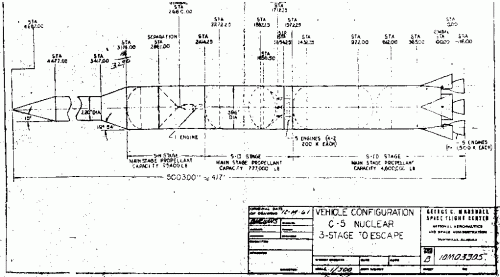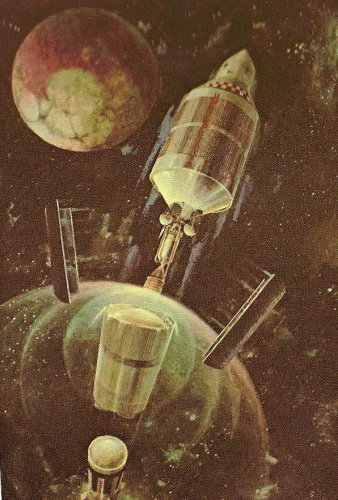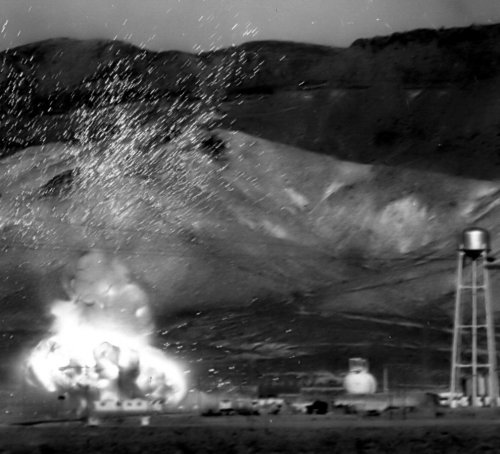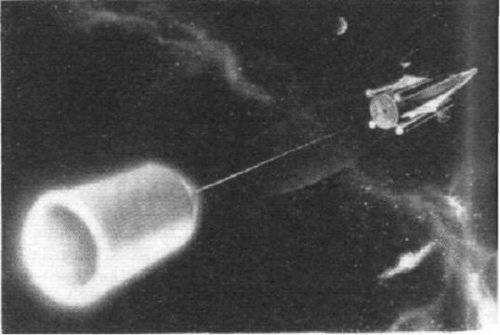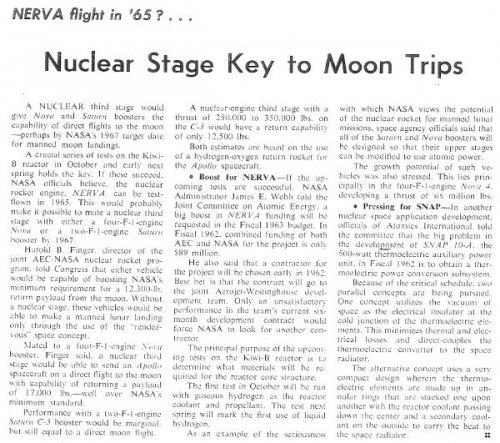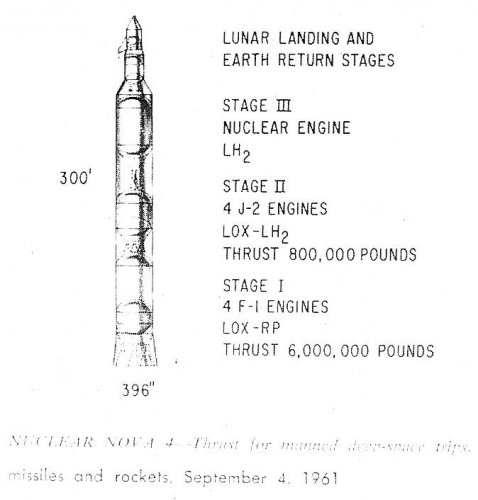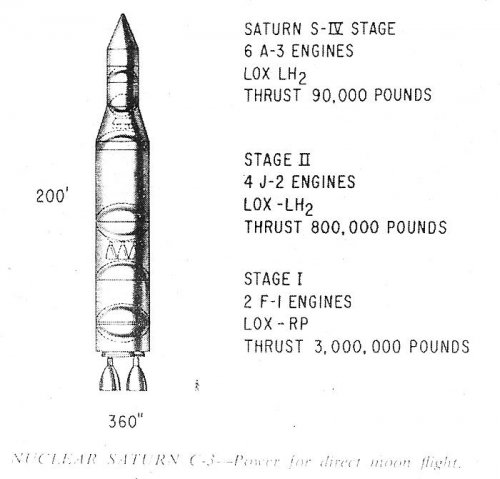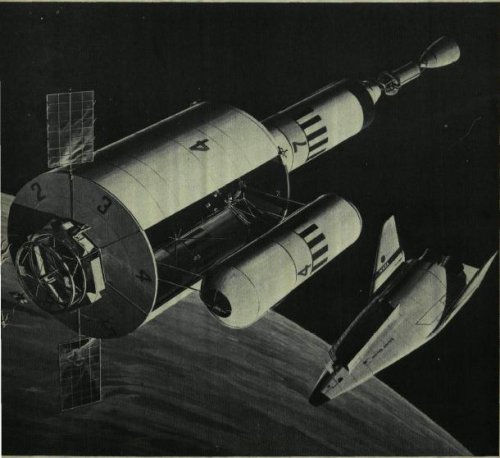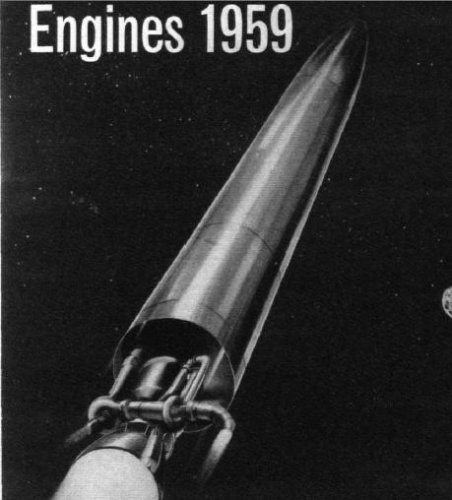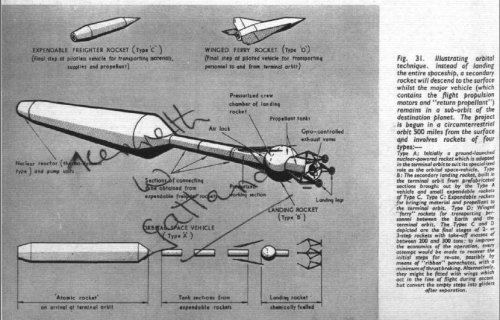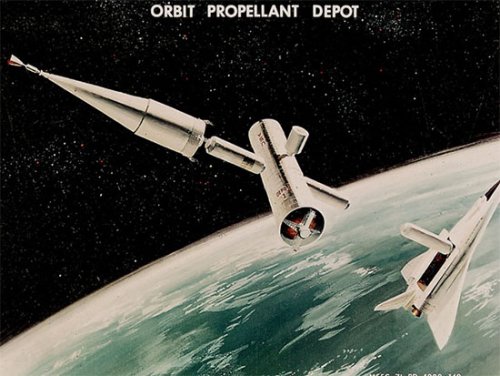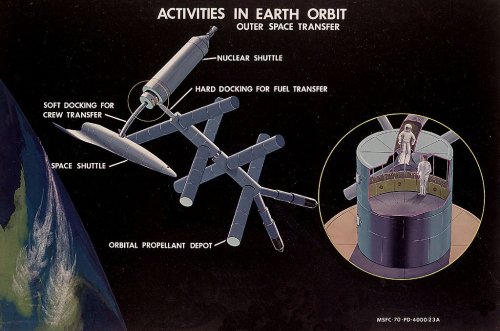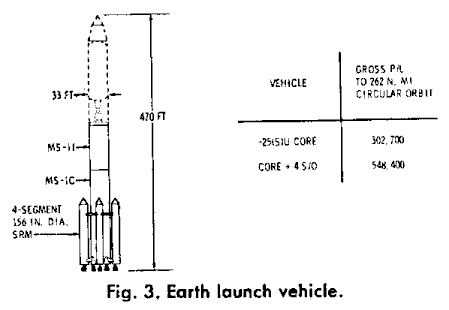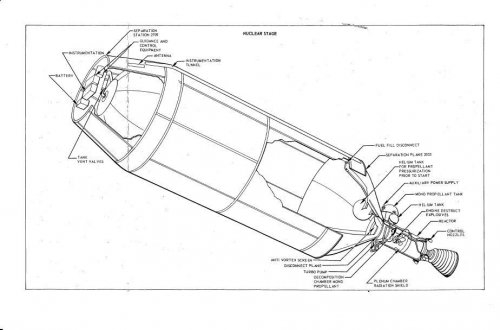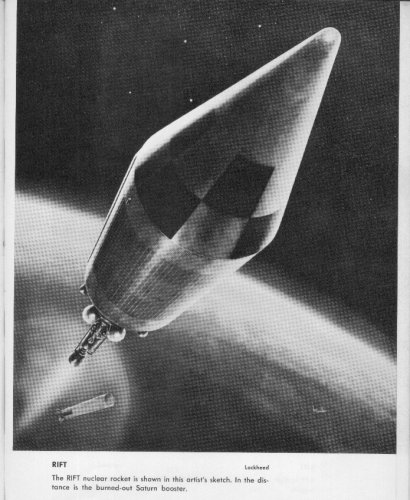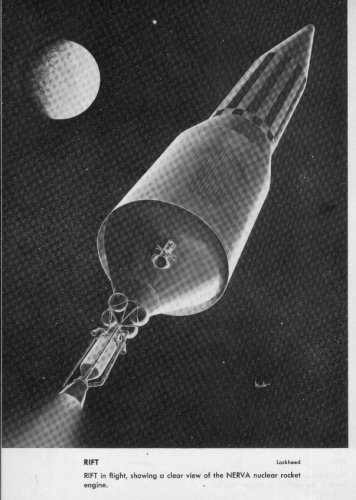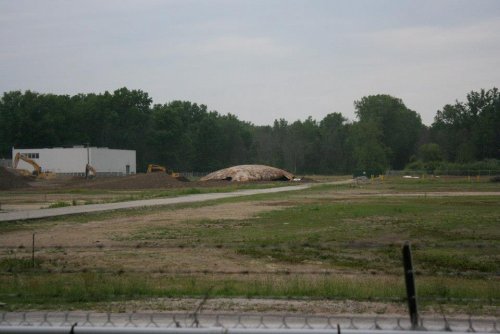You are using an out of date browser. It may not display this or other websites correctly.
You should upgrade or use an alternative browser.
You should upgrade or use an alternative browser.
Nuclear Powered Spacecraft
- Thread starter Antonio
- Start date
pometablava said:Found this article at Flight archive. A nuclear Saturn V is illustrated
http://www.flightglobal.com/PDFArchive/View/1967/1967%20-%200502.html
The same vehicle that I recently posted PDF/CD-ROM papers of.
"Integrated Manned Interplanetary Spacecraft Concept Definition"

http://www.up-ship.com/drawndoc/drawndocspacesaturn.htm#spacedoc29
The page is a bit of a mess just now... bear with the changes.
But it's either the same vehicle described in "Flight," or a generic version of it (often detailed corporate designs are based on generic NASA designs... such as the Shuttle.

http://www.up-ship.com/drawndoc/drawndocspacesaturn.htm#spacedoc29
The page is a bit of a mess just now... bear with the changes.
But it's either the same vehicle described in "Flight," or a generic version of it (often detailed corporate designs are based on generic NASA designs... such as the Shuttle.
- Joined
- 13 August 2007
- Messages
- 7,876
- Reaction score
- 9,002
Nuclear Saturn rocket was planed in begin 1960s
In 1961 there were study of Saturn I with small nuclear stage as RIFT (Reactor In Flight Test)
http://www.astronautix.com/lvs/satirift.htm
then bigger Saturn for Apollo and again later for RIFT
Saturn C-3N http://www.astronautix.com/lvs/satnc3bn.htm
Saturn C-5N http://www.astronautix.com/lvs/satrnc5n.htm
Nuclear powered spacecraft
The first Idea they need only one big Engine and put Fueltanks around
like The first NASA study of a manned Mars expedition, from 1960 NASA's Lewis Research Center
but AEC Test smaller and Smaller NERVA engine
drop Dumbo nuclear engine design because of Budget cuts
more on Dumbo Hightrust Engine here http://www.dunnspace.com/00339489.pdf
end 1960s the Multistage NERVA Concept pop up everywere
NASA Marshall von Braun 1968 Mars expedition, at Boeing with IMIS 1968 or Rockwell and TWR Concept.
more links to NERVA and NTR
http://www.projectrho.com/rocket/rocket3c2.html
nice list of NTR Engine include ORION and the infamous Zubrin "Nuclear Salt water Engine".
http://klabs.org/history/ntrs_docs/other/nuclear/
more on NTR with stuff like:
"Feasibility study of a tungsten water-moderated nuclear rocket. - 1968"
"Reactor in-flight test system. Volume 1: RIFT program summary - 1961"
http://orion.ttsw.com/
More On Nuclear Puls Engine
In 1961 there were study of Saturn I with small nuclear stage as RIFT (Reactor In Flight Test)
http://www.astronautix.com/lvs/satirift.htm
then bigger Saturn for Apollo and again later for RIFT
Saturn C-3N http://www.astronautix.com/lvs/satnc3bn.htm
Saturn C-5N http://www.astronautix.com/lvs/satrnc5n.htm
Nuclear powered spacecraft
The first Idea they need only one big Engine and put Fueltanks around
like The first NASA study of a manned Mars expedition, from 1960 NASA's Lewis Research Center
but AEC Test smaller and Smaller NERVA engine
drop Dumbo nuclear engine design because of Budget cuts
more on Dumbo Hightrust Engine here http://www.dunnspace.com/00339489.pdf
end 1960s the Multistage NERVA Concept pop up everywere
NASA Marshall von Braun 1968 Mars expedition, at Boeing with IMIS 1968 or Rockwell and TWR Concept.
more links to NERVA and NTR
http://www.projectrho.com/rocket/rocket3c2.html
nice list of NTR Engine include ORION and the infamous Zubrin "Nuclear Salt water Engine".
http://klabs.org/history/ntrs_docs/other/nuclear/
more on NTR with stuff like:
"Feasibility study of a tungsten water-moderated nuclear rocket. - 1968"
"Reactor in-flight test system. Volume 1: RIFT program summary - 1961"
http://orion.ttsw.com/
More On Nuclear Puls Engine
Attachments
Lauge
ACCESS: Secret
- Joined
- 30 January 2008
- Messages
- 434
- Reaction score
- 53
I'm confident that the answer to the following question is buried somewhere in the masses of nuclear-powered spacecraft documentation available on the internet or in bookstores (and a considerable amount available via links from this excellent website). I am, however, of a rather lazy nature (;D), so I decided to take a short-cut and pose the question here:
Just how radioactive is the exhaust from a solid-core, nuclear-thermal rocket (e.g. NERVA) using hydrogen as reaction mass ? Hydrogen is a lightweight, simple molecule, and it spends only a short time in the reactor, so it shouldn't get all that radioactive. On the other hand, there's probably some erosion of the reactor's moderator going on, contaminating the exhaust with radioactive carbon, beryllium and whatnot.
The US (and probably the USSR) tested NERVA-type engines in the past, so I assume that some measurements were made ? Also, the very fact that the were tested would seem to indicate that the exhaust wasn't glow-in-the-dark radioactive ???.
Regards, and thanks in advance,
Thomas L. Nielsen
Denmark
Just how radioactive is the exhaust from a solid-core, nuclear-thermal rocket (e.g. NERVA) using hydrogen as reaction mass ? Hydrogen is a lightweight, simple molecule, and it spends only a short time in the reactor, so it shouldn't get all that radioactive. On the other hand, there's probably some erosion of the reactor's moderator going on, contaminating the exhaust with radioactive carbon, beryllium and whatnot.
The US (and probably the USSR) tested NERVA-type engines in the past, so I assume that some measurements were made ? Also, the very fact that the were tested would seem to indicate that the exhaust wasn't glow-in-the-dark radioactive ???.
Regards, and thanks in advance,
Thomas L. Nielsen
Denmark
- Joined
- 13 August 2007
- Messages
- 7,876
- Reaction score
- 9,002
good question
Strangely the in the masses of nuclear-powered spacecraft documentation available on the internet
are very vague about this
Wat i known:
a unshielded working Nerva engine would kill astronauts on distance of 14 km or 8,69 miles in space
The crew is protected by a "shadow shield" between the NERVA engine and crew Mission Module
can be like water, liquid hydrogen propellant tanks, lithium hydride, paraffin or a hydrogenated polyethylene composite.
Shield builds up after webpage Atomic Rocket
NERVA "shadow shield" had to be Mercury and lithium hydride
to the exhaust
Hydrogen will not much radioactive
but the exhaust gas will be contaminating with piece of reactor core !
the Tory A Nuclear Ramjet engine had that Problem during test
yep they tested Nuclear Aircraft engine and Nuclear rocket engine in USA and USSR
they tested ROVER (KIWI, Phoebus, NERVA, Tory A and others nuclear engine ) in Nevada 1959
in place called "Jackass Flats" west of Nuclear Bomb Test Rage.
first as USAF/AEC study for ICBM Nuclear rocket engine ! (the USSR also)
later under NASA/AEC in 1960 until stop of program in January 1973
the test were made as the wind blow from south, so L.A. and Las Vegas were "Save"
on of the test this happens : KIWI engine at full power and its EXPOLDE !

safety regulation say stay away 100 km from testside after use for some weeks (in wind direction)
Wat indicates that after a NERVA test the area was about radioactive with deathly 500 Milli rem
Strangely the in the masses of nuclear-powered spacecraft documentation available on the internet
are very vague about this
Wat i known:
a unshielded working Nerva engine would kill astronauts on distance of 14 km or 8,69 miles in space
The crew is protected by a "shadow shield" between the NERVA engine and crew Mission Module
can be like water, liquid hydrogen propellant tanks, lithium hydride, paraffin or a hydrogenated polyethylene composite.
Shield builds up after webpage Atomic Rocket
http://www.projectrho.com/rocket/rocket3ah.html18 centimeters of beryllium (which acts as a neutron reflector), followed by 2 centimeters of tungsten (mainly a gamma-ray shield but also does a good job on neutrons), and finally 5 centimeters of lithium hydroxide (To stop the remaining neutrons. Hydrogen slows down the neutrons and lithium absorbs them.). This attenuates the gamma flux to a value of 0.00105, and neutron flux to 4.0e-9. This has a mass of 3,500 kilograms per square meter of shadow shield
NERVA "shadow shield" had to be Mercury and lithium hydride
to the exhaust
Hydrogen will not much radioactive
but the exhaust gas will be contaminating with piece of reactor core !
the Tory A Nuclear Ramjet engine had that Problem during test
yep they tested Nuclear Aircraft engine and Nuclear rocket engine in USA and USSR
they tested ROVER (KIWI, Phoebus, NERVA, Tory A and others nuclear engine ) in Nevada 1959
in place called "Jackass Flats" west of Nuclear Bomb Test Rage.
first as USAF/AEC study for ICBM Nuclear rocket engine ! (the USSR also)
later under NASA/AEC in 1960 until stop of program in January 1973
the test were made as the wind blow from south, so L.A. and Las Vegas were "Save"
on of the test this happens : KIWI engine at full power and its EXPOLDE !

safety regulation say stay away 100 km from testside after use for some weeks (in wind direction)
Wat indicates that after a NERVA test the area was about radioactive with deathly 500 Milli rem
Attachments
Bump!
Ok, I've red Stephen Baxter voyage this weekend (700 pages in english in three days : )
)
This is a novel, so no idea about how close from real thing it is (probably far)
My question
Was the Nerva flawed (and dangerous) in its basic concept, Ie no chance at all to push a spacecraft to Mars (even if NASA has had the budget back in 1971) ?
Or was there a chance it worked well ?
Ok, I've red Stephen Baxter voyage this weekend (700 pages in english in three days :
This is a novel, so no idea about how close from real thing it is (probably far)
My question
Was the Nerva flawed (and dangerous) in its basic concept, Ie no chance at all to push a spacecraft to Mars (even if NASA has had the budget back in 1971) ?
Or was there a chance it worked well ?
- Joined
- 13 August 2007
- Messages
- 7,876
- Reaction score
- 9,002
that big question
the prototype work well in Jack Ass Flats in Nevada
but put a NERVA with nozzle in wrong way up and fire it.
and put under rocketstage and launch in to space and Ignites it.
are two different things
is likely that first or second RIFT (Reactor In Flight Test)
can NERVA go over critical like Baxter Apollo-N mission.
for Manned Mars Mission you need big trust NERVA engine
Boeing IMIS project need 265 tons thrust NERVA
Von Braun 1968 needs 176 Tons thrust NERVA
trust of last NERVA prototype XE : 27 Tons
the prototype work well in Jack Ass Flats in Nevada
but put a NERVA with nozzle in wrong way up and fire it.
and put under rocketstage and launch in to space and Ignites it.
are two different things
is likely that first or second RIFT (Reactor In Flight Test)
can NERVA go over critical like Baxter Apollo-N mission.
for Manned Mars Mission you need big trust NERVA engine
Boeing IMIS project need 265 tons thrust NERVA
Von Braun 1968 needs 176 Tons thrust NERVA
trust of last NERVA prototype XE : 27 Tons
OM
ACCESS: Top Secret
Archibald said:Was the Nerva flawed (and dangerous) in its basic concept, Ie no chance at all to push a spacecraft to Mars (even if NASA has had the budget back in 1971) ?
...Something to keep in mind about Baxter's Voyage is that he uses an Alternate Timeline plot device that comic book fans know as the "Post-Crisis Historical Plot Hole", which basically states that if you prevent something from happening in an alternative history story, the "energy" is still there and must be filled in by something "similar". Hence Apollo-N's failure to coincide with Apollo 13 in OTL. While NERVA never got anywhere near flight test, they made more progress with it than they're usually given credit for. IMHO, had the events in Voyage come to pass, I think NERVA would have probably been a bit more successful, and we damn sure wouldn't have done an all-up manned test with a NERVA like we did with Apollo 4. We'd have done several unmanned tests before even considering putting a man in front of one.
- Joined
- 26 May 2006
- Messages
- 33,564
- Reaction score
- 13,690
Hi,
a nuclear-powered rocket of 1951.
http://www.flightglobal.com/pdfarchive/view/1951/1951%20-%201495.html
a nuclear-powered rocket of 1951.
http://www.flightglobal.com/pdfarchive/view/1951/1951%20-%201495.html
Attachments
- Joined
- 26 May 2006
- Messages
- 33,564
- Reaction score
- 13,690
Attachments
- Joined
- 13 August 2007
- Messages
- 7,876
- Reaction score
- 9,002
i guess, this Nuclear Tug is launch with engine upwards inside aerodynamic cover...
Michel Van said:i guess, this Nuclear Tug is launch with engine upwards inside aerodynamic cover...
The artwork is depicting a refueling operation and not a launch. The fuel receptacle is at the top of the vehicle and required a hard docking with the orbital fuel depot. Since it is using the top port the tug is inverted for refueling with liquid hydrogen.
Remember the line drawing of the Saturn V-25(S)U for the Boeing IMIS spacecraft with the NERVA engine pointed downward? Refer to attached drawing labeled "Earth Launch Vehicle." The nuclear stage replaces the S-IVB third stage and the NERVA engine replaces the J-2 rocket engine in the Saturn stack.
Documents that I have read state that the Nuclear Shuttle would be launched from a Saturn INT-21 and no mention is made of 156" solid rocket boosters being required.
Topic about the Nuclear Tug/Shuttle:
http://www.secretprojects.co.uk/forum/index.php/topic,6177.0.html
Attachments
Final Report to NASA: Reactor-in-Flight Test System Study (RIFT) by Missiles and Space Engineering, Douglas Aircraft Company, March 1961
http://ntrs.nasa.gov/archive/nasa/casi.ntrs.nasa.gov/19760071825_1976071825.pdf
Reactor in-flight test system. Volume 1: RIFT program summary by Missiles and Space Engineering, Douglas Aircraft Company, March 1961
http://ntrs.nasa.gov/archive/nasa/casi.ntrs.nasa.gov/19740074802_1974074802.pdf
RIFT Reactor In Flight Test. Volume 4: Manufacturing Transportation Schedules and Costs Final Report Phase II by Missiles and Space Engineering, Douglas Aircraft Company, December 1961
http://ntrs.nasa.gov/archive/nasa/casi.ntrs.nasa.gov/19760065928_1976065928.pdf
http://ntrs.nasa.gov/archive/nasa/casi.ntrs.nasa.gov/19760071825_1976071825.pdf
Reactor in-flight test system. Volume 1: RIFT program summary by Missiles and Space Engineering, Douglas Aircraft Company, March 1961
http://ntrs.nasa.gov/archive/nasa/casi.ntrs.nasa.gov/19740074802_1974074802.pdf
RIFT Reactor In Flight Test. Volume 4: Manufacturing Transportation Schedules and Costs Final Report Phase II by Missiles and Space Engineering, Douglas Aircraft Company, December 1961
http://ntrs.nasa.gov/archive/nasa/casi.ntrs.nasa.gov/19760065928_1976065928.pdf
Attachments
- Joined
- 1 November 2009
- Messages
- 638
- Reaction score
- 410
I found these two illustrations (credited to Lockheed) in
Rockets and Spacecraft of the World
By Michael Chester
W. W. Norton & Co. Inc. 1964
From the book
Rockets and Spacecraft of the World
By Michael Chester
W. W. Norton & Co. Inc. 1964
From the book
The development of advanced propulsion systems is concentrated mainly in nuclear reactor engines at the present time. The Nerva is a rocket engine being manufactured for use with a nuclear reactor. The entire nuclear power system will be flight tested by RIFT vehicle. RIFT will be boosted into space by the Saturn C5.
The Nerva engine is destined to be part of a nuclear spacecraft called Rover. Rover is to be boosted into space in the late 1960s by advanced Saturn or Nova rockets.
Attachments
- Joined
- 9 October 2009
- Messages
- 21,147
- Reaction score
- 12,249
A report from 1989 called 'Advanced Power Sources for Space Missions': http://www.dtic.mil/dtic/tr/fulltext/u2/a345765.pdf
- Joined
- 9 October 2009
- Messages
- 21,147
- Reaction score
- 12,249
A late '80s study incorporating both nuclear and non-nuclear related systems carried out by TRW for the Aero Propulsion Laboratory at Wright-Patterson Air Force Base:
MEGAWATT SPACE POWER
CONDITIONING, DISTRIBUTION,
AND CONTROL STUDY
March 1988
Final Report for Period September 1985 to September 1987
MEGAWATT SPACE POWER
CONDITIONING, DISTRIBUTION,
AND CONTROL STUDY
March 1988
Final Report for Period September 1985 to September 1987
- Joined
- 9 October 2009
- Messages
- 21,147
- Reaction score
- 12,249
- Joined
- 26 September 2008
- Messages
- 1,935
- Reaction score
- 680
Thanks for that. It's a short document, but it's nice to see that it discusses SNAP-8.
I had one of my ah-ha moments several years ago when I stumbled across SNAP-8. If you look at just about every space history book about the 1960s, especially broad ones that cover multiple activities beyond human spaceflight, you will find virtually no mention of the SNAP-8 reactor program. It's just not recorded. You'll see discussion of the RTGs, which had odd numbers such as SNAP-9, 11, etc. And you might see SNAP-10 and 10A mentioned (the very small nuclear reactor that the United States flew was SNAP-10A, so it gets a little bit of print). But SNAP-8 is just missing (I think that the same is true for SNAP-2).
But several years ago I stumbled across some documentation on SNAP-8 and it turns out that it was a BIG program. The Atomic Energy Commission and NASA spent a lot of money on what was supposed to be a pretty powerful nuclear reactor. Of course, NASA was throwing around a lot of money in the mid-1960s for advanced space programs. They were doing a lot of testing and were exploring options for using SNAP-8. But it got canceled without ever flying, and then it sank without much of a trace.
I had one of my ah-ha moments several years ago when I stumbled across SNAP-8. If you look at just about every space history book about the 1960s, especially broad ones that cover multiple activities beyond human spaceflight, you will find virtually no mention of the SNAP-8 reactor program. It's just not recorded. You'll see discussion of the RTGs, which had odd numbers such as SNAP-9, 11, etc. And you might see SNAP-10 and 10A mentioned (the very small nuclear reactor that the United States flew was SNAP-10A, so it gets a little bit of print). But SNAP-8 is just missing (I think that the same is true for SNAP-2).
But several years ago I stumbled across some documentation on SNAP-8 and it turns out that it was a BIG program. The Atomic Energy Commission and NASA spent a lot of money on what was supposed to be a pretty powerful nuclear reactor. Of course, NASA was throwing around a lot of money in the mid-1960s for advanced space programs. They were doing a lot of testing and were exploring options for using SNAP-8. But it got canceled without ever flying, and then it sank without much of a trace.
You forgot blatantly ripping off other books wholesale. A lot of VOYAGE is lifted almost direct from ANGLE OF ATTACK by Mike Gray on NAA/Harrison Storms.OM said:...Something to keep in mind about Baxter's Voyage is that he uses an Alternate Timeline plot device that comic book fans know as the "Post-Crisis Historical Plot Hole", which basically states that if you prevent something from happening in an alternative history story, the "energy" is still there and must be filled in by something "similar".
blackstar said:But several years ago I stumbled across some documentation on SNAP-8 and it turns out that it was a BIG program. The Atomic Energy Commission and NASA spent a lot of money on what was supposed to be a pretty powerful nuclear reactor. Of course, NASA was throwing around a lot of money in the mid-1960s for advanced space programs. They were doing a lot of testing and were exploring options for using SNAP-8. But it got canceled without ever flying, and then it sank without much of a trace.
Aerojet General SNAP-8 Fission Reactor
Thermal Power: 300 kW(t)
Electrical Power: 30 kW(e)
Mass: 300 lbs (reactor); 1500 lbs (unshielded system)
Useful Life: 12 months.
Reactor Outlet Temperature: 1,300°F
Mercury Boiling Temperature: 1,100°F
Radiator Temperature: 700°F
Notes: Joint NASA/AEC project designed to develop a 30 to 60 KW(e) reactor with a specific weight of 50 lb/kw(e) and a 10,000 hour operational lifetime. Effectively a scale-up of the SNAP-2 system. The official objective was:
<blockquote></blockquote>“The ultimate objective of the SNAP-8 program is to design and develop a 30-kw Electrical Generating System for use in various space missions. The power source for this system will be a nuclear reactor furnished by the AEC. The SNAP-8 system will use a eutectic mixture of sodium and potassium (NaK) as the reactor coolant; the system will operate on a Rankine cycle with mercury as the working fluid for the turbogenerator. The SNAP-8 system will be lightweight and highly reliable. It will be launched from a ground base and will operate unattended at full power for a minimum of 10,000 hours. After the system is placed in orbit, both activation and shutdown may be accomplished by ground command.”
Two complete reactors were built during the SNAP-8 program:
SNAP-8 Experimental Reactor (S8ER), which was ground tested in an inerted containment vessels for 12,000 hours and operated for 1 year at power and temperature. Used non-flight hardware. Was a significant improvement in technology – for the same amount of unshielded reactor mass as a SNAP-10A system, S8ER could deliver over 6 times the energy.
SNAP-8 Developmental Reactor (S8DR), which was ground tested for 7,000 hours at power levels from 600 to 1,000 kW(t) using flight-type reactor components and neutron shielding.
References:
Novel Power Sources for Survival Shelters (Contract OCD-OS-62-243) March 1963 (3.9 MB PDF)
Quarterly Progress Report to the Joint Committee on Atomic Energy, April-June 1958. U.S. Atomic Energy Commission
AEC Annual Report to Congress, 1961.
Summary of Snap Nuclear Space Power Systems, E.B. BAUMEISTER
Report No. 0390-04-6 Development of SNAP-8 Nuclear Power Conversion System Model AGAN 0010 (7 February 1962)
Technological Implications of SNAP Reactor Power System Development for Future Space Nuclear Power Systems Activities by R.V. Anderson (9.1 MB PDF)
SNAP Overview by Glen Schmidt (7 February 2011) (7.39 MB PDF)
An Appraisal of the Advanced Electric Space Power Systems, May 1962 by Lewis Research Center (NASA)
-----------------------
Sadly...if I had known that moron Frank Wolf was going to destroy NTRS, I would have made all the references I found mirrored on my website as well.
- Joined
- 19 February 2007
- Messages
- 1,288
- Reaction score
- 2,191
Quite so. But putting the "North American Aviation" clone in Newport Beach was amusing - for one thing, there is no airport there...much less the infamous Bandini Mountain nearby. Oh - maybe Baxter was thinking of the Ford Aeronutronic site. Or maybe it was pure handwavium.RyanCrierie said:You forgot blatantly ripping off other books wholesale. A lot of VOYAGE is lifted almost direct from ANGLE OF ATTACK by Mike Gray on NAA/Harrison Storms.
XP67_Moonbat
ACCESS: Top Secret
- Joined
- 16 January 2008
- Messages
- 2,259
- Reaction score
- 461
From False Steps, something on the reusable Nuclear Shuttle.
http://falsesteps.wordpress.com/2013/09/27/the-reusable-nuclear-shuttle-to-the-moon-again-and-again/
http://falsesteps.wordpress.com/2013/09/27/the-reusable-nuclear-shuttle-to-the-moon-again-and-again/
- Joined
- 26 September 2008
- Messages
- 1,935
- Reaction score
- 680
XP67_Moonbat said:From False Steps, something on the reusable Nuclear Shuttle.
http://falsesteps.wordpress.com/2013/09/27/the-reusable-nuclear-shuttle-to-the-moon-again-and-again/
Wow, I had just about deleted False Steps from my bookmarks. Glad to see it back!
- Joined
- 9 October 2009
- Messages
- 21,147
- Reaction score
- 12,249
http://www.technologyreview.com/news/414770/a-lunar-nuclear-reactor/
Recently declassified internal budget documents show that, in 1962, the US Air Force had plans to build entire fleets of giant Orion spacecraft, and was prepared to commit almost 20 percent of its requested space budget from 1963 to 1967 to its realization.
Wow,a USAF Spacefleet!
That nasty McNamara...if only Nixon had won in 1960!


Flyaway said:Talking of nuclear powered spacecraft.
http://www.thespacereview.com/article/2714/1
Hindsight being 20/20... isn't the idea of a spaceship that leaves a trail of hundreds of nuclear explosions, a somewhat ludicrous idea?
- Joined
- 9 October 2009
- Messages
- 21,147
- Reaction score
- 12,249
'Get there fastest with the mostest' was the general idea, and out of atmosphere the Orion drive was quite a reasonable concept.
Not to mention that, in an all out WWIII scenario, you'd have other things to worry about than from some modest atmospheric contamination...
Not to mention that, in an all out WWIII scenario, you'd have other things to worry about than from some modest atmospheric contamination...
- Joined
- 9 October 2009
- Messages
- 21,147
- Reaction score
- 12,249
Back to the present, or there abouts, with this SPACENEWS article from last year that may be of some interest: http://spacenews.com/41399europa-clipper-would-wash-out-other-nuclear-powered-missions/
- Joined
- 3 June 2011
- Messages
- 17,895
- Reaction score
- 10,971
Grey Havoc said:Back to the present, or there abouts, with this SPACENEWS article from last year that may be of some interest: http://spacenews.com/41399europa-clipper-would-wash-out-other-nuclear-powered-missions/
Wow, that is just sad. I had no idea our capability there had deteriorated so far.
Similar threads
-
USAF interplanetary spacecraft concept using SPUR
- Started by Triton
- Replies: 15
-
-
-
-
General Electric Mars Mission Study July 19, 1967.
- Started by Michel Van
- Replies: 4

